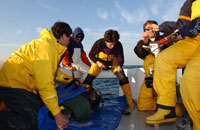The 2008 New Zealand Pacific bluefin satellite tagging effort is underway. I reunited with Pete Saul and colleagues, John Holdsworth (Bluewater Marine Research) and Tim Sippel (Auckland University) in Greymouth on August 16, 2008 for another shot at tagging the giant tuna off the West Coast of New Zealand’s South Island.
Figure 1. Greymouth, New Zealand, August 16, 2008: A view from the Cova Rose (Image: George Shillinger)

As always, weather is a limiting factor in our New Zealand tuna tagging efforts. August is a harsh month in the Roaring Forties, and the South Tasman Sea presents a challenging work environment for fishers and scientists alike. The Bluefin sportfishery here is opportunistic and good weather is never taken for granted. We were fortunate to arrive in concert with a ridge of high pressure, and seized the opportunity to begin our deployment efforts.
We joined Captain Tony Roach (Chinner) and his deckies, Norm and Bryce (Big Boy) on the vessel Cova Rose for our tagging expedition.
Figure 2. Angler Mark Hemmingway awaits as deckies Bryce and Norm bait bluefin.
(Image: George Shillinger)

Over the course of the next 48 hours, we fished alongside two trawlers from the Hoki fleet and tagged seven fish, ranging from an estimated 200-350 kg (~350-620 lbs). We were aided in our efforts by a group of game fishing enthusiasts from the New Zealand Big Gamefishing Council, including Mark Hemmingway (one at ~240 kg and another at ~ 250 kg), Vance Fulton (~320 kg), Clyde Frazier (~200 kg), and Dave Wallace (~ 350 kg), I was granted a rare opportunity to battle a giant and brought a estimated 250 kg fish to the leader in 62 minutes, which was tagged by Tim Sippel.
Figure 3. Hoki trawler which attracts bluefin. (Image: George Shillinger)

Figure 4. A hefty bluefin being tagged just before being released.
(Image: George Shillinger)

The deckies, Norm and Bryce, handlined another giant tuna with an estimated weight of 280 kg in a span of fifteen minutes! Handlining has proven to be an effective technique for getting the fish to the boat quickly but the tradeoff is that the fish are livelier (greener) and more difficult to handle – thus making it difficult to position the fish for tagging and DNA collection.
Figure 5. Deckie Norm reaching out to sample DNA with a small fin clip.
(Image: George Shillinger)

Towards the end of our Cova Rose charter, Captain Larry Johnston, of the Cerveza 2, invited me to transfer to his boat to join a 48 hour charter. The anglers on the boat were familiar with our research efforts, having previously invited Pete Saul to join them during 2007. Captain Larry put us on fish and angler Denis Lucardie captured a fish weighing an estimated 310 kg and Frank Foster caught another weighing an estimated 280 kg. Deckies, Adrian and Redz brought the fish to leader, adding another two fish to our tagging tally.
As dusk approached on the second day of the Cerveza charter, I was granted an opportunity to join another charter on the vessel, Oracle, captained by Mike Boswell, and crewed by Bevan Johnson (Beefy). The crew and anglers on the Oracle were enthusiastic about the opportunity to support our research efforts. Andrew Clavroueh (~ and Aaron Hunter pulled in two fish respectively weighing an estimated 240 and 260 kg. The Oracle fishing approach involves stand-up gear, where the angler has to support the full weight of rod and fish without the aid of a gamefish chair.
Figure 6. Angler Aaron Clavroueh battling a bluefin on stand-up gear.
(Image: George Shillinger)

Figure 7. Tuna tagger turned tuna angler, George Shillinger.
(Image: George Shillinger)

Forty eight hours later, we wrapped up the Oracle charter and headed to the landings at Westport, approximately 90 km north of Greymouth. At the docks, I collected another five samples of DNA and muscle tissue from fish that had been landed by other crews. The Westport fishery represents one of two recreational fishing ports on New Zealand’s South Island West Coast – the other being Greymouth.
We are excited by the reception that we have received in Greymouth and Westport, and the support and genuine interest that we have encountered from the fishing fleets. Tomorrow, the team from Bluewater Marine and Auckland University will be heading to Westport to discuss management of the NZ bluefin recreational fishery and to provide feedback on the results of previous tagging efforts with fishery stakeholders (captains and crews). I will be heading offshore on the Cerveza 2 with the Greymouth Gourmet Guzzlers and high hopes for a repeat of our successful tagging efforts during 2007.
Figure 8. “Greymouth Guzzlers” accompanied by George Shillinger before departing for their next tagging adventure on 25 August 2008.





